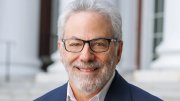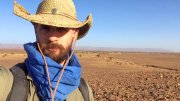Two hundred fifty-two million years ago, the rapid buildup of carbon dioxide in Earth’s atmosphere caused one of the largest mass extinctions in the history of life on our planet: the Permian extinction.
Andrew H. Knoll, Fisher professor of natural history and earth and planetary sciences, emeritus, was one of the scientists who first hypothesized that this buildup of CO2 resulted in the death of 90 percent of Earth’s animals. Less than 5 percent of all species in the seas survived, and less than one-third of large land animals remained.
Knoll’s research focuses on the early history of life and the evolution of Earth’s surface environments, spanning the Archean and Proterozoic eons (from approximately 4 billion years ago to 541 million years ago), especially early microbial life, the rise of eukaryotes, and the emergence of complex organisms near the end of the Precambrian period. Knoll has also studied patterns of phytoplankton evolution and mass extinction events. (Harvard Magazine reviewed his book, A Brief History of Earth: Four Billion Years in Eight Chapters, in 2021.)
In addition to his study of ancient Earth, he has contributed to NASA’s Mars exploration program, bringing a planetary perspective to the search for past life on Mars.
1. What do you study at Harvard, and what drew you to this field?
As an undergraduate with no sense of direction, I took courses in biology and geology and loved them both. It somehow dawned on me that these were not the separate universes that they seemed to be, based on how they were taught. That realization provided the direction and motivation I needed, and for the past half-century I have studied the interactions between Earth and life that shape the world around us.
2. You’ve studied life across billions of years. What is the most misunderstood aspect of Earth’s biological history?
The timetable of evolution is something to wrap our heads around. Dinosaurs may seem impossibly ancient, and in some ways, they are, but when the first dinosaurs appeared, life on Earth was already more than three and a half billion years old. Indeed, microbial life was more than three billion years old before any animals graced our planet. I’ve long emphasized to students that what may distinguish Earth is not that life took root here, but that it has persisted so long.
3. Your research has helped illuminate the causes and consequences of Earth’s mass extinctions. What do those losses and renewals reveal about life’s adaptability?
‘My’ extinction is the big one—252 million years ago, when some 90 percent of animal species in the oceans disappeared. Peculiar features of limestones deposited at the time of the extinction led my colleagues and me to investigate the biological consequences of a rapid increase in atmospheric carbon dioxide levels. Three months in the library, reading many years of physiological experiments, gave us a sense of the types of animals that would be vulnerable to such an event, and those that should be tolerant. This turned out to provide a good fit to the actual pattern of biological selectivity at the time of the extinction. We now know that the source of the CO2 was massive volcanism. This ancient extinction provides a distant mirror to the twenty-first century, when rapid carbon dioxide increase is again influencing biology, this time because of us.
The early evolution of terrestrial ecosystems is well documented in rocks deposited between about 500 and 360 million years ago. Land plants, animals, and, not to be forgotten, fungi, all evolved from aquatic ancestors. Their fossils provide an illuminating record of how structural innovations, one after another, enabled them all to function on dry land. Today, half of all photosynthesis and most animal and fungal species are terrestrial, the legacy of those early adaptations to life on land.
4. What scientific question keeps you up at night or fuels your curiosity today?
These days, I’m all phytoplankton, all the time, as I try to understand the evolutionary history of photosynthetic microorganisms in the oceans. It turns out that if we want to understand the history of animal life in the oceans, we need to understand phytoplankton evolution. If, in turn, we want to understand the phytoplankton evolution, we need to understand the history of nutrient availability. And if we want to understand the history of nutrients, we need to understand tectonics through time. Earth and life in a four-billion-year conversation.
5. What advice would you give to students who are curious about big-picture questions like the evolution of life, but don’t yet know how to find their scientific voice?
Be curious. You need some disciplinary expertise—scientists need to do something well—but avoid disciplinary silos. Many of the outstanding questions in science require interdisciplinary research, requiring that we read, learn, and converse across disciplinary boundaries. Certainly, this is necessary if we want to understand our planet’s past—and future.









